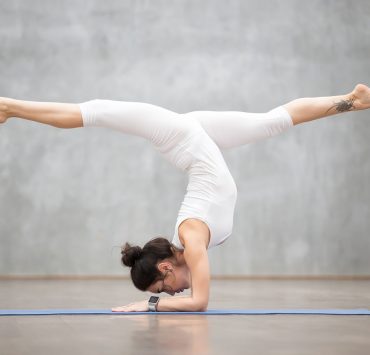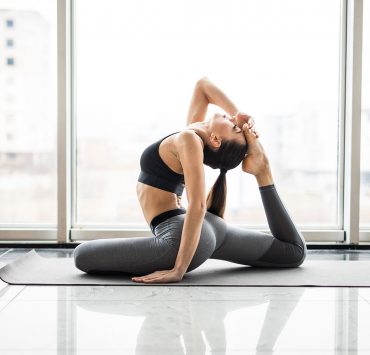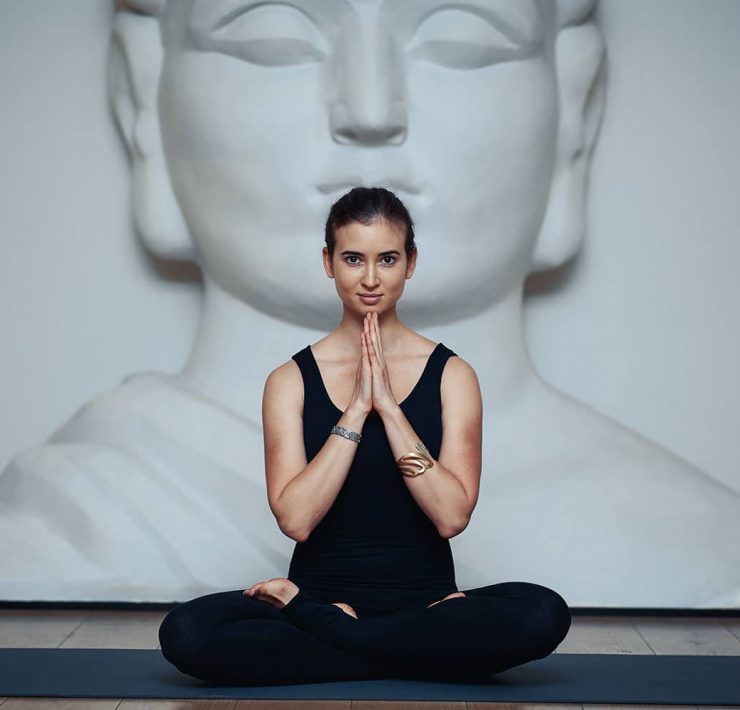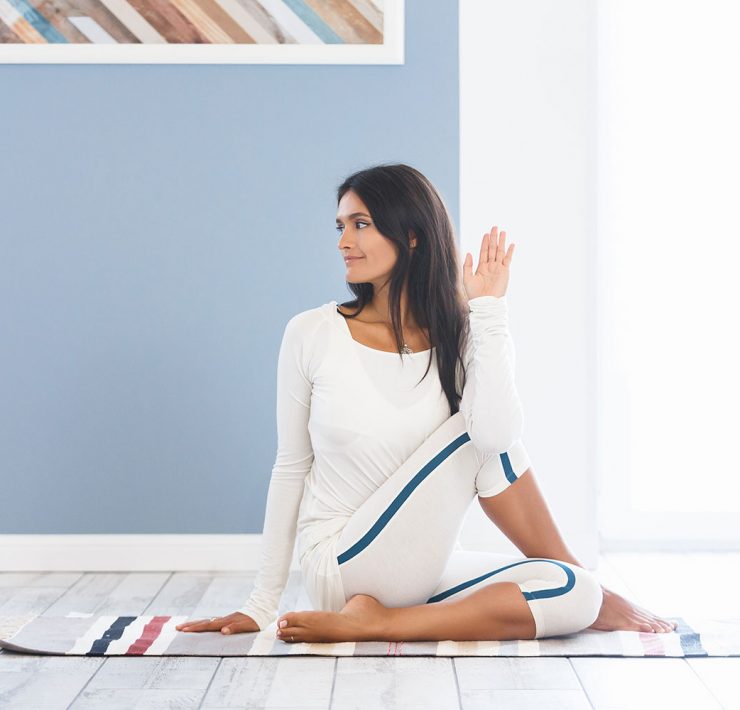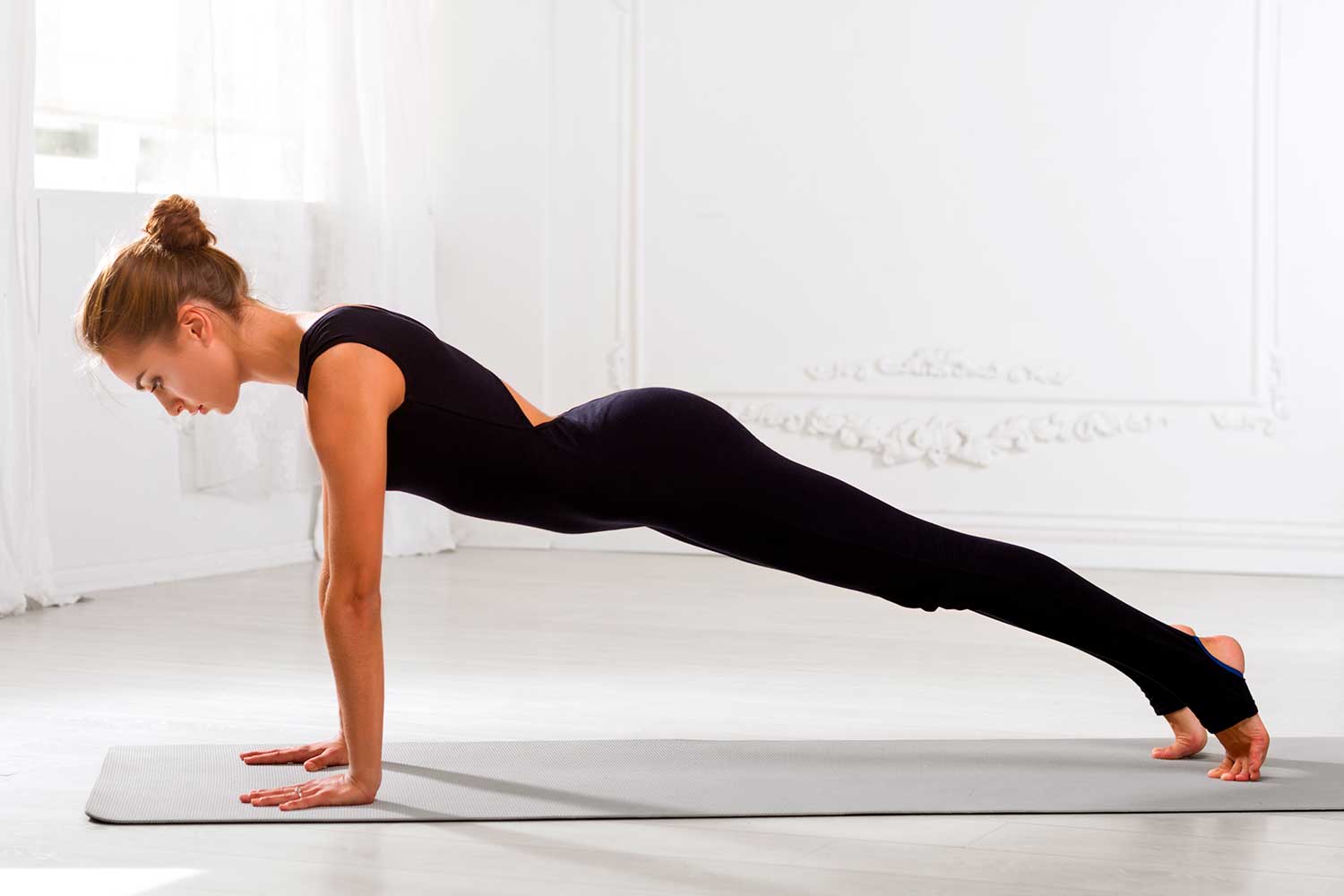
Rose graduated with a degree in Anthropology, which takes her…
Of all the yoga poses, plank pose is perhaps the most widely pervasive in outside schools of exercise. This could be due to its wide array of anatomical benefits. Plank pose is known by a variety of different names, and many yoga teachers even refer to plank pose as ‘top of the push-up.’ In Sanskrit, there is not really a consensus on what plank pose is named. It is called Phalakasana, Santolasana, Utthita Chatturanga Dandasana, or Kumbakhasana. This variety of names is a reflection on the many ways plank pose is used in yoga.
Plank Pose

Plank pose is most commonly used as a transitional pose, moving the body from high to lower planes, and vice versa. It is used within the sun salutation (surya namaskara) sequences and vinyasa sequences, as the yogi steps back to plank and lowers into chatturanga. Plank pose is also known as a pose in its own right, and is often held for long periods of time to build strength, heat, and energy in the body. Because plank pose requires a certain extent of strength and endurance, it is an ideal pose to refocus and re-energize, and overcome from sluggish energy or ‘stuck’ emotions.
How To Enter Plank Pose (With Correct Form)

There are various ways to enter plank pose, and the three main ways will be discussed herein. However, although these three ways to enter plank pose are the most common, they are not exclusive, and there are other ways to incorporate plank pose within a yoga sequence as well.
Stepping Back To Plank Pose
Within the sun salutation sequence, the yogi inhales and lifts to a half flat back at the front of their mat. On an exhale, the yogi plants their palms on the mat, shoulder-width apart, and steps the legs back to plank pose. This may be held for one breath or many, before the yogi lowers into chatturanga to complete the sequence.
Lifting Up To Plank Pose

This transition to plank pose requires the most amount of core strength. Starting from chatturanga, where the elbows are bent straight back in a right angle, and the whole body is held at shoulder height, the yogi inhales and lifts up into plank pose. This is a very difficult way to enter plank pose because the yogi is acting against gravity, rather than with it. A good modification to make this transition more accessible is to lower the knees to the mat.
Shifting Forward To Plank Pose

Plank pose can also be reached from downward facing dog in a simple and elegant transition. In downward facing dog, the yogi’s hands are already planted shoulder width apart, and there is ideally a body’s length between the hands and feet. The yogi merely has to inhale and press back in downward facing dog, and then exhale and shift the body weight forward into plank pose, so the shoulders are positioned above the wrists.
Common Mistakes In Plank Pose

Plank is a deceptively complicated pose. It looks simple on the surface, but there are many common mistakes that people do not even realize they are doing in plank pose. Some of these common mistakes are rounding the upper back, dropping or lifting the head, dumping into the low back, not supporting the shoulders, lifting their tailbone in the air, and more.
To perfect alignment in plank pose, the yogi should think of their body lifting up and above the pose, rather than sinking into the pose. The hands should be planted shoulder width apart, and the yogi should press evenly through all four corners of the palms, rather than dumping into any one area. The arms are engaged with the muscles hugging the bones. The balls of the feet are planted on the mat about frontal hips’ width apart, and the yogi engages the leg muscles, lifting the knee cap and engaging the quads. The core is engaged and the belly button is lifting up toward the spine, with the tail bone reaching toward the back of the room and the crown of the head reaching toward the front of the room.
Anatomical Benefits Of Plank Pose
Plank pose carries many anatomical benefits due to not only its positioning of the skeletal system, but also due to the consistent contraction of many muscle groups. As such, it is an ideal pose for people seeking to strengthen their arms, back, and core. It also has lesser known anatomical benefits such as increasing bone density and subsequently preventing osteoporosis. These benefits are discussed in greater detail below.
Strengthens The Triceps Muscle

Many people focus on strengthening their triceps muscles because the triceps contribute definition to the backs of the arms. However, there are also functional advantages to a strengthened triceps muscle such as better ability to lift objects and reduce fatigue. Plank pose is a powerful and useful way to strengthen and tone the triceps muscles. During plank pose, the arms are in a static position. The triceps muscles are engaged for the duration of the pose, in what is called an isometric contraction. This continual contraction of the triceps muscles will lead to stronger triceps, particularly as the duration and consistency of plank is built up over time.
Strengthens the Core

In many athletic disciplines outside of yoga, plank pose is used as an exercise to build a stronger core. Within yoga, other elements such as the breathing (pranayama) and mindfulness are also emphasized when practicing plank pose. However, plank pose’s ability to strengthen the core muscles is undeniable. A strong core is very important in yoga and will lead to increased endurance, improved posture, and improved ability in other yoga poses. Strong core muscles also have benefits off the mat such as reducing back pain, protecting inner organs, protecting the nervous system, and more. The core is made up of the muscles that are anatomically at the ‘core’ or center of the body. These muscles include both superficial and deep muscles, as well as anterior (front body) and posterior (back body) muscles. Specific muscles in the core are the internal and external obliques, the transverse abdominus, multifidi, erector spinae, and more. All of these muscles are engaged when practicing plank pose. In particular, plank pose strengthens the transverse abdominus which is a deep muscle, and can help with advancing in other poses such as inversions.
Improves Bone Health

One littler known benefit of plank pose is that it can improve bone health. Women in particular are at risk of osteoporosis as they age, a condition where the bones lose their density, which can lead to stress fractures or broken bones. Yoga in general is a powerful tool when it comes to bone health: by putting stress on the bones through body-weight supported poses and continuous muscle contractions, yoga can build bone density. Plank pose specifically builds bone mass in the hands, wrists, feet, arms, and shoulders. Other bones throughout the body may be strengthened as well, as the yogi builds up muscle and further contracts around bones such as the spine, hips, and legs. Plank is also an easily modifiable pose, so it is appropriate for people who are already living with osteoporosis and want to recover and prevent further degeneration. Examples of modifications include lowering to the knees, lowering to the forearms, or side planks.
Strengthens The Back Muscles

Consistent plank pose practice will help strengthen the back muscles. These muscles include primarily postural muscles, or muscles that help sustain a static position over a long period of time. These muscles are very important as they are used throughout the day whether a person is standing or sitting. Strong postural muscles around the spine can prevent back pain or conditions such as slipped discs. Plank pose strengthens these postural muscles of the back such as the multifidi, erector spinae, transverse abdominus, rotator, and rhomboids. Plank is a useful alternative to other exercises, such as sit ups, when it comes to strengthening the back. This is because it does not put undue pressure on the hips or spine.
Strengthens The Thigh Muscles

Due to the previously mentioned isometric (or constant) contractions that occur during plank pose, the thigh muscles are also strengthened. These muscles (called the quadriceps femoris) are one of the largest skeletal muscle groups in the human body, and consist of the vastus lateralis, vastus medialis, rectus femoris, and vastus intermedialis. During plank pose, yoga teachers often advise to ‘lift the kneecaps.’ What this action is doing is engaging the quadriceps muscles. By keeping these muscles engaged throughout plank pose, they are strengthened. However, often yogis will forget about their quadriceps in plank, and dump more of their weight and energy into the shoulders and hands. By engaging the quadriceps, not only are these muscles strengthened, but injury or undue stress in other parts of the body are reduced.
Improves Posture

Perhaps one of the most meaningful anatomical benefits of plank pose is the extent to which it can improve a person’s posture. Posture is incredibly important for all areas of a person’s health. Not only does good posture give off an impression of confidence to other people, but it also has an internal effect on a person’s state of mind. Anatomically, good posture can reduce chronic pain, prevent uneven weight distribution throughout the body, and prevent injuries both big and small. Plank is a wonderful pose to improve posture because of the variety of both muscular and skeletal areas it strengthens. As mentioned, plank pose increases strength in the core, which supports the spine, as well as the back. Furthermore, it strengthens the thighs, shoulders, arms, wrists, hands, and feet. Even its ability to increase body density can have positive effects on maintaining good posture with age.
Risks Of Plank Pose
There are various risks to plank pose that may offset its anatomical benefits. All yoga poses carry risks and contraindications, which is why it is important for yogis to honor their individual body and own personal edge, as well as to receive safe instruction from a certified yoga teacher. Most risks related to plank pose are injuries or pain that result from misalignment. There are many possible misalignments in plank, as discussed previously. Additionally, alignment tends to deteriorate over time, as muscles fatigue. Compared to other poses, plank is often held for longer periods of time. As time goes on the muscle groups will fatigue, increasing chance of misalignment and risk of injury. It is a lesson in both humility and ego, but it is very important for the yogi to modify or bow out of poses when misalignments begin to occur. Some of the most common injuries that result from plank pose misalignments are discussed below.
Shoulder Injury

One of the most common injuries associated with plank pose is shoulder injury. In most cases, shoulder injury results from an inappropriate balance of weight (often discussed by yoga teachers as ‘dumping into the shoulders’) and a lack of core strength. It may be surprising, but most yoga related injuries occur during transitions rather than in statically held poses. This is true for plank. Plank pose is an important part of the vinyasa sequence; After plank pose, the yogi often lowers down into chatturanga, where the elbows are bent back and the body is held straight at shoulder-height. This transition is where injury to the shoulders’ rotator cuffs may occur, if the yogi is dumping their weight into this muscle group. The solution to this is twofold. First, the yogi will need to modify plank pose and the plank-chatturanga transition by lowering to their knees. This modification can be used as the yogi builds up core strength. Core strength is integral to preventing shoulder injuries, as the yogi engages their core muscles to support the body weight during transition.
Wrist Injury

Wrist injury is another associated risk of plank pose. Additionally, prior wrist injuries will become aggravated in plank pose. The wrist is a delicate joint made up of eight carpal bones. In plank pose, it is in full extension (bent back with the palms flat on the floor), and is supporting body weight. Many yogis do not practice correct positioning of the hands, and end up pressing into the wrist joint and heels of the hands, subsequently putting a huge amount of pressure and body-weight through these fragile joints. These misalignments can lead to wrist injuries, the most common being tendonitis (inflammation of the wrist tendons) and ganglion cysts (a fluid-filled pocket on the wrist tendon sheath). Both of these conditions are very painful and may need medical attention such as aspiration, surgery, immobilization, or physical therapy. By practicing proper form in plank, yogis can prevent wrist injuries before they impact their yoga practice and life off the mat.
Beyond Anatomy: Mind And Spirit Benefits Of Plank Pose

As with all yoga poses, the benefits extend beyond the purely physical realm. Plank pose can have profound effects on the mind and spirit. First, the anatomical benefits such as improved strength and posture can have carry-on effects and increase confidence and mood.
Additionally, plank awakens prana within the body. In yoga, prana is said to be the ‘vital life force’ or energy that flows along meridians within the body. Sometimes, prana becomes ‘stuck,’ and this can lead to imbalances, disease, or stagnation of energy. Anatomically, plank pose requires a strong and engaged core. This, in turn, awakens prana within the belly area, which begins to move throughout the body and energize both the mind and spirit.
Plank pose is associated with the third chakra, or manipura chakra, located in the belly or solar plexus area. The third chakra affects will power, determination, and confidence. When it becomes blocked or sluggish, a person may become complacent in life, or feel like they have lost energy and direction. Plank pose is a powerful tool to stir this chakra to life, and increase feelings of determination and will.
Perhaps as a result of all these physical and spiritual benefits, plank is also said to increase mental focus and concentration. Just as plank is a powerful way to build bodily strength, it also builds strength of will power and focus. These mental effects continue after yoga practice and can have wonderful resounding effects throughout a person’s life.
Conclusion
In most schools of yoga, particularly vinyasa yoga, plank pose is a central pose. It has a wide array of anatomical benefits such as strengthening major muscle groups like the core, improving posture, and promoting bone health. When practiced regularly it can enable not only physical health, but also associated mental and emotional wellbeing. Plank pose has risks and contraindications, just like all yoga poses, and should be practiced with proper alignment to minimize risk of injuries.
What's Your Reaction?
Rose graduated with a degree in Anthropology, which takes her understanding of basic human needs to a whole new level. Her intelligence and passion for healthy living is reflected in her written work.






